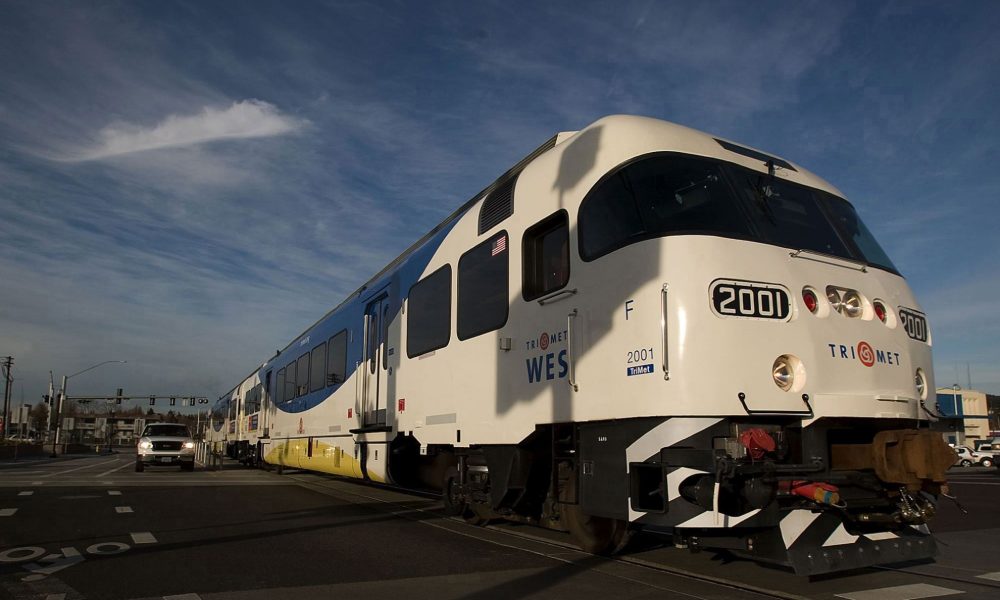
A WES commuter train pulls into the Beaverton station. A legislator dreams of pushing the service south to Salem. (File/Pamplin Media Group)
SALEM — Ten years ago, the Westside Express Service began running between Beaverton and Wilsonville.
State Rep. Mitch Greenlick hopes that in another 15 years, it will run south to Oregon’s capital city.
House Bill 2219 would commission a 17-member task force to study the concept of extending WES commuter rail to Salem, determining whether it would be feasible or beneficial. The bill received an initial public hearing before the Legislature’s Joint Transportation Committee on Monday, March 4. No committee vote has yet been scheduled to advance the legislation.
“It would make WES much more viable,” Greenlick said before the hearing. “I think WES would be much more effective if it had the riders that would come from … the north Salem area.”
WES is part of the TriMet system, which treats bus, light rail and commuter rail fares as interchangeable. The typical fare is $2.50 for two and a half hours, or $5 for a full day.
Like nearly all commuter rail systems, WES operates at a loss, meaning a trip costs more than what the rider pays for it. An average commuter trip costs TriMet $18.14. That makes WES considerably more expensive to operate, relative to the number of riders, than TriMet’s bus and light rail services. MAX’s average operating cost per ride is $2.95.
Ridership on WES has also been decreasing year over year, which TriMet spokeswoman Roberta Altstadt attributes to business closures along the commuter route. Last fiscal year, WES provided 265,668 rides — on average, 5,109 trips per week.
“Those who do ride WES often call it the best kept secret as it provides a quick, reliable and comfortable ride between Wilsonville and Beaverton,” Altstadt said.
A 2010 state study concluded that extending WES to Salem was “technically feasible,” but it would be a complex project that would cost up to $387 million to build. The amount TriMet must spend for WES operations every year would likely triple, the study added. It made no recommendation on how to proceed, and the idea got little further public attention.
Greenlick is restarting the conversation.
Shelley Snow, Oregon Department of Transportation spokeswoman, said in an emailed statement, “We understand the goal of the bill’s sponsor and should the bill pass, we look forward to participating in the task force and/or in any other way that would be helpful.”
Express transit between Wilsonville and Salem exists today in the form of bus line 1X, which runs as a partnership between Wilsonville’s bus service SMART and Salem-area transit operator Cherriots.
Cherriots did not respond to a request for comment, but SMART transit director Dwight Brashear praised Greenlick’s bill at Monday’s committee hearing.
“I think this is an opportunity for us to study something that will benefit future generations to come,” Brashear testified.
SMART and Cherriots track ridership for all of their routes, including bus line 1X. Last fiscal year, the route averaged 1,386 boardings per week, with SMART serving the majority of them.
Officials from Beaverton and Wilsonville testified in favor of Greenlick’s bill. In a letter of support, Wilsonville Mayor Tim Knapp suggested SMART could “re-deploy assets” to cover other unserviced areas if WES was extended to Salem.
Officials in Tigard and Tualatin are watching as well. Sherilyn Lombos, Tualatin city manager, said her City Council supports extending WES.
“Anything that adds service to Tualatin, we’re interested in,” Lombos said.
Interstate 5 runs through Tualatin and Wilsonville, and during peak commute hours, the freeway can become choked with vehicles. Lombos and Knapp see a WES extension as potential congestion relief.
“If existing commuters from the south to Tualatin used this new WES extension, it would reduce the number of vehicles coming to Tualatin and using the roads,” Lombos said. “I would think that the same would be true for commuters going south.”
“As the Portland metro region increases in population and jobs, the area’s freeway arterials are reaching peak traffic-handling capacity,” Knapp wrote. “And as housing costs escalate in the Portland area, more workers are living outside the metro region, leading to increased commuting on highways.”
The website RENTCafé, which tracks the rental market, suggests the average rent for an apartment in Salem and Keizer is roughly three-quarters what renters in Beaverton, Tualatin and Wilsonville can expect to pay. It’s the same story for real estate, with price-tracking website Zillow clocking the average home value in Salem at $280,400 — about 70 percent of Beaverton’s.
“I believe that we can have increased residential strength around Keizer and this area — between, say, Donald and here,” Greenlick said in an interview. “And that would really require not putting people on I-5. It would require having an alternative to getting to work in, say, Hillsboro, or even downtown Portland. It would be a much handier commute if we had that.”
Greenlick’s bill requires the task force to report to the Legislature by Sept. 15, 2020.
Beaverton and Wilsonville would have seats on the task force. So would the cities of Woodburn, Donald, Salem and Keizer, as well as Cherriots, TriMet, ODOT, the Portland & Western Railroad, and both Washington and Marion counties.
If the task force does recommend extending WES, it would be only the start of a years-long process.
“I think it’ll take at least 15 years from the time we really start taking it seriously,” Greenlick said. “You have to get started far in advance of when you need it to be on the ground.”









